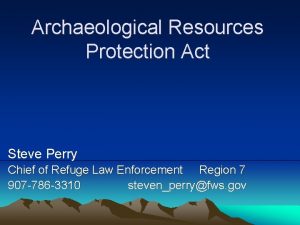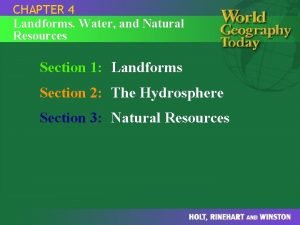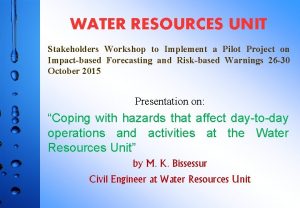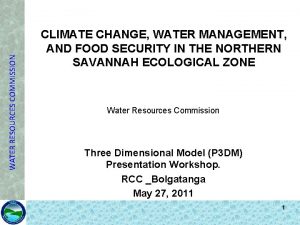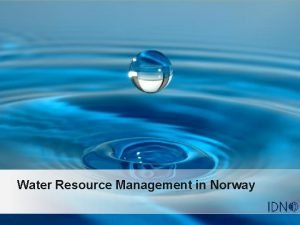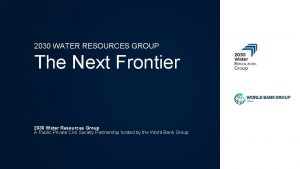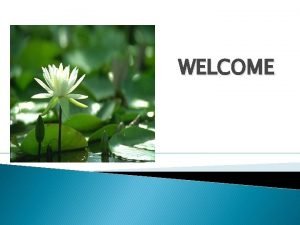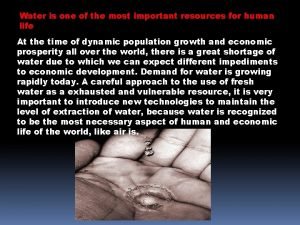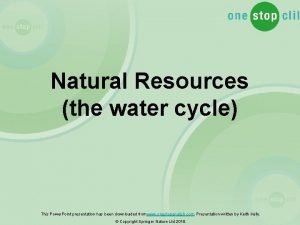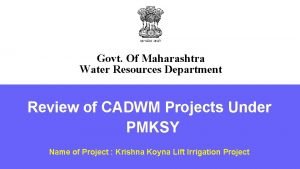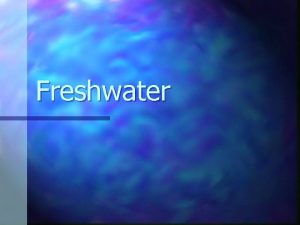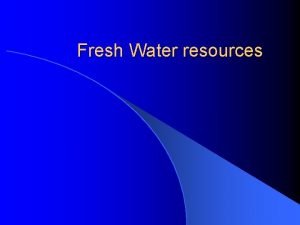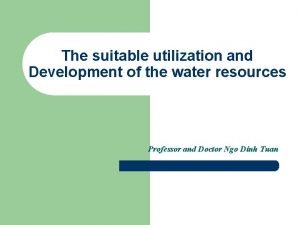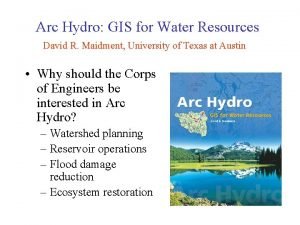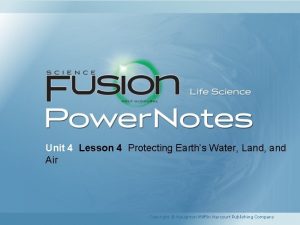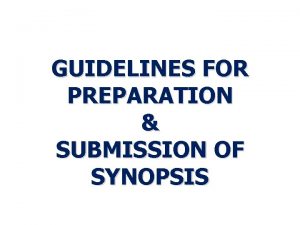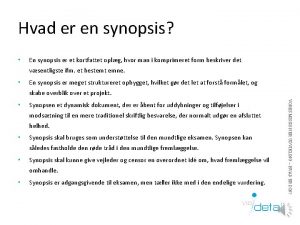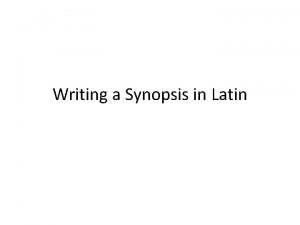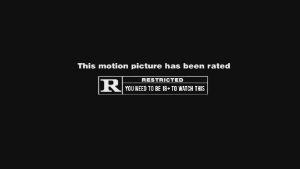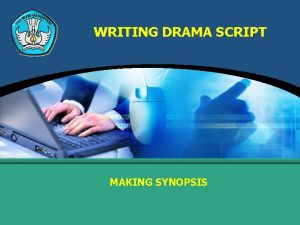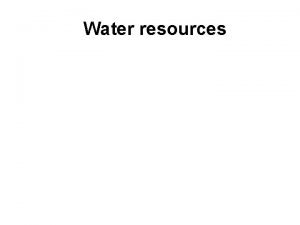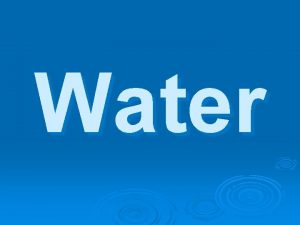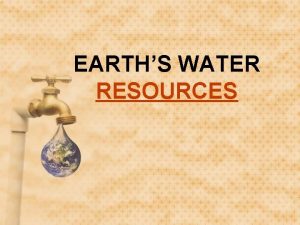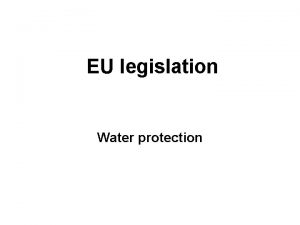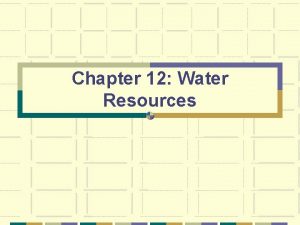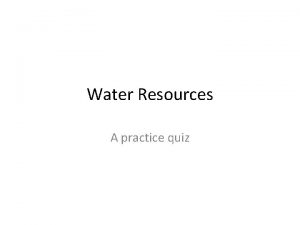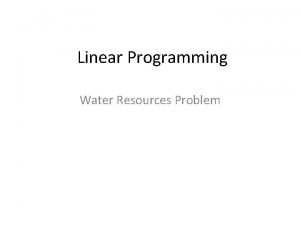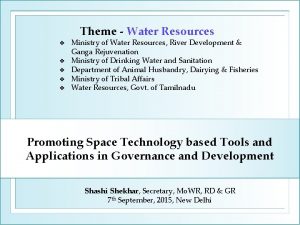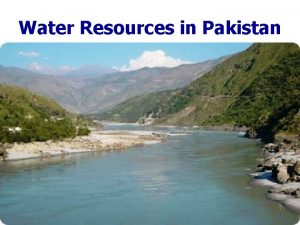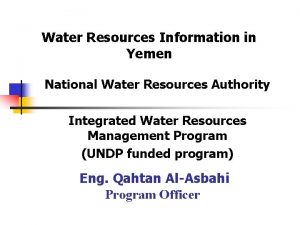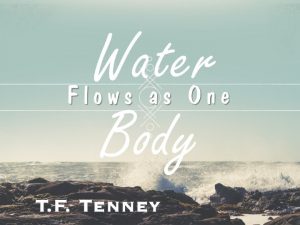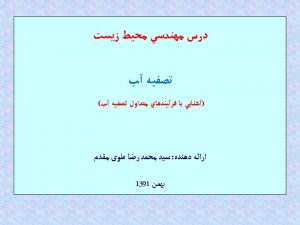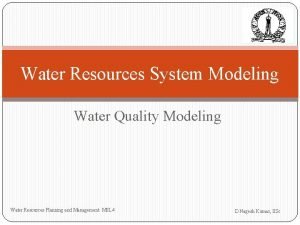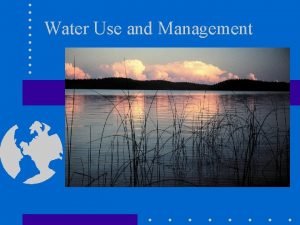PROTECTION OF WATER RESOURCES 1 CHAPTER SYNOPSIS Students

























- Slides: 25

PROTECTION OF WATER RESOURCES 1

CHAPTER SYNOPSIS Students will know what are the laws provisions in EQA 1974, and also other related laws, that concerns for the protection of our clean water resources 2

CHAPTER OUTLINE q Environmental Quality Act q Local Government Act q Street, Drainage & Building q Drainage Works Act q Sabah Water Resources Enactment 3

EQA (Sewage & Industrial Effluent) Regulations 1979 �Effluent: means sewage or industrial effluent �Industrial effluent: liquid water or wastewater produced by reason of the production process taking place at any industrial premises �Inland waters: include any reservoir, pond, lake, river, stream, canal, drain, spring or well, any part of the sea abutting on the foreshore, and any other body of natural and artificial surface or subsurface water �Sewage: any liquid or wastewater discharge containing animal or vegetable matter in suspension or solution, and may include liquids containing chemicals in solution �Treatment Plant: facility for the conditioning of effluent to effect reduction or partial of its potential to cause pollution sewage or industrial effluent 4

EQA (Sewage & Industrial Effluent) Regulations 1979 Application: �These regulations shall apply to discharges of effluent into any inland waters, OTHER THAN the effluents discharged from prescribed premises or other premises specified in the First Schedule or both (*BOTH, they have their own legislation). �Prescribed premises: � Oil Palm Mill - processing palm oil � Rubber Factory - processing raw natural rubber � Scheduled Wastes Treatment and Disposal Facilities 5

EQA (Sewage & Industrial Effluent) Regulations 1979 First Schedule (Regulation 3): 1. Processing of oil-palm fruit into crude palm oil 2. Processing of natural rubber in technically specified form, latex, conventional sheet, crepe or scrap rubber 3. Mining activities 4. Processing, manufacturing, washing and servicing any products or goods: �That produce effluent of less than 60 m 3/day �That the effluent does not contain contaminant listed as parameters (vi) to (xvi) in the first column of the Third Scheduled (Hg, Cd, Cr(VI), As, Cyanide, Pb, Cr(III), Cu, Mn, Sn). �Where the total load of BOD of the effluent (20 o. C, 5 days) or suspended solid or both shall not exceed 6 kg/day (100 mg/L) �In any housing or commercial development or both of less than 30 units without affecting the generality of 4(3). 6

EQA (Sewage & Industrial Effluent) Regulations 1979 Main elements: �All sources of effluent discharge are required to obtain written permission from the Director General of DOE. �Fee: RM 100 �Written Permission application: �Certified building plan �Effluent treatment system plan �Technical calculation of effluent treatment capacity �Water quality monitoring programme �Standard Method of analysis of effluents - Second Schedule (Regulation 7): using Standard Methods of the Examination of Water and Wastewater published by APHA (American Public Health Association) 7

EQA (Sewage & Industrial Effluent) Regulations 1979 Main elements: �Standard of discharge: �Two Standard: A & B � Std A: if the effluent is discharge upstream of any water intake � Std B: if the effluent is discharge downstream of any water intake �Discharge or disposal of effluent on land is required written permission �Contravention license - can apply to contravene the term and condition - for improvement purpose only: the applicant need to inform the justification for the application �Operating without Written Permission - Compoundable of RM 2, 000 maximum �Fine and Penalty (Court) - RM 100, 000 or 5 yrs imprisonment 8

Standard of Effluent Discharge (Standard A & Standard B) 9

EQA (Prescribed Premise)(Crude Palm Oil) Regulations 1978 �Prescribed Premise: means any premises that being premises occupied or used for the processing of oil palm fruit or oil palm fresh fruit bunches into crude palm oil, whether as an intermediate or final product �Watercourse: include any reservoir, pond, lake, river, stream, canal, drain, spring or well, any part of the sea abutting on the foreshore, and any other body of natural and artificial surface or subsurface water 10

EQA (Prescribed Premise)(Crude Palm Oil) Regulations 1978 Main elements: �This premise is required to be licensed and the requirement for the licensing are: �Presiting approval (for the proposed location) �Written Permission for the Effluent Treatment System �Written Approval for the fuel burning equipment (boiler, chimney, generator sets, incinerator, etc) �The license fee are depending on the calculated BOD load �Standard of effluent discharge Standard - Second Schedule [Regulation 12(2) and (3)] �Effluent discharge can be on land or watercourse �Fine and Penalty - Contravention of license - RM 100, 000 or 5 yrs 11

EQA (Prescribed Premise)(Crude Palm Oil) Regulations 1978 Standard Limit: Parameter BOD(3 days 30 °C) COD Total solid Suspended Solid Oil and Grease Ammoniacal Nitrogen Total Nitrogen p. H Temperature Schedule 2 Limits (mg/L) 100 400 50 150 200 5 -9 45°C Note: DOE can set more stringent limit than in Schedule 2 � On to land - BOD can be discharged not more than 5000 mg/L 12

EQA (Prescribed Premise)(Raw Natural Rubber) Regulations 1978 �Prescribed Premise: means any premises that being premises occupied or used for the processing of: � raw natural rubber in etchnically specified form, latex form including prevulcanised or the form of modified and special purpose rubber, and � conventional sheet, skim, crepe, or nay other form of raw rubber not already described in quantities of 5 tonnes or more per day or with a production or processing capacity of a similar quantity 13

EQA (Prescribed Premise)(Raw Natural Rubber) Regulations 1978 Main elements: �This premise is required to be licensed and the requirement for the licensing are: �Presiting approval (for the proposed location) �Written Permission for the Effluent Treatment System �Written Approval for the fuel burning equipment (boiler, chimney, generator sets, incinerator, etc) �The license fee are depending on the calculated BOD load �Standard of effluent discharge Standard – Second Schedule [Regulation 12(2) and (3)] �Effluent discharge can be inland or watercourse �Fine and Penalty - Contravention of license - RM 100, 000 or 5 yrs imprisonment 14

EQA (Prescribed Premise)(Raw Natural Rubber) Regulations 1978 Standard Limit: (on watercourse and on to land) Schedule 3 (latex) Parameter Watercourse (mg/L) BOD(3 days 30°C) 100 COD 400 Total solid Suspended Solid 150 Ammoniacal Nitrogen 300 Total Nitrogen 300 p. H 6 -9 Schedule 2 (Latex) On to land (mg/L) 6000 12, 000 13, 000 500 900 1, 100 3. 5 -8. 0 �Note: DOE can set more stringent limit than these 15

EQA 1974 Section 25: pollution on inland waters �Subsection (1) No person shall discharge or deposit any environmentally hazardous substances pollutants or waste into any inland waters, UNLESS licensed. �Subsection (3)Any person contravenes, fine maximum RM 100, 000 or 5 yrs imprisonment or both. �Further fine, maximum RM 1, 000 for everyday the offence continued. �Subsection (2) Offender: place waste to access to any waters; alter the nature and temperature of the water. 16

EQA 1974 Section 29 : prohibition of discharge waste �Subsection (1)No person shall discharge environmentally hazardous substances , pollutants or wastes into the Malaysian waters, UNLESS licensed. �Subsection (2) Any person contravenes, fine maximum RM 500, 000 or 5 yrs imprisonment or both. 17

EQA 1974 Section 34 B : prohibition against placing, deposit of scheduled wastes �Subsection (1)No person shall place, deposit or dispose any scheduled waste on land or into Malaysian waters, except at prescribed premises only and has written approval from the Director General of DOE. �Subsection (4) Any person contravenes, fine maximum RM 500, 000 or 5 yrs imprisonment or both. 18

Local Government Act 1976 �To overcome the pollution of rivers and other water channels such as drains, that caused from activities of people living in the area which is under the local government authorities, some specific prohibition of certain acts were imposed under the Local Government Acts, which includes: � Section 69: committing nuisance or deposits any filth in or upon the bank of stream, channel, public drain or other water course. Contravenes , fine maximum RM 2, 000 or 1 yr imprisonment or both. Further fine, RM 500 for each day during the offence continued after the conviction. � Section 70: prevention of streams with trade refuse (waste from manufacturing industry, quarry waste, rubbish and uses for laundry trade. Contravenes, fine maximum RM 5, 000 or 2 yrs or both. Further fine, RM 500 for each day offence continued. 19

Street, Drainage & Building Act 1974 �Controlling pollution and harm to water resources through water ponds, waterways, drains and other water course by illegal drains alteration. �Section 55: no person shall made any drain into canal or streams, closes or deviates any drains, without written permission from the local authority. Contravenes, fine maximum RM 1, 000 and the owner required by Magistrate Court to demolish, alter or remake such drain as the Court thinks fit. �Section 56: water closet (from toilet) or privy and trade effluent not to communicate with river, canal, stream, pond, lake, sea , public surface or storm water drain without permission from local authority. Penalty, maximum RM 1, 000 and demolish or alter. 20

Drainage Works Act 1954 �From Drainage Works Ordinance 1954 and became an Act in 1988 after been reviewed and amended. �Controlling water pollution that can caused from drainage system: �Section 11: prohibit interfere with drainage works (blocks, obstruct, encroaches, cuts, breached, places fish trap, grow fruits across the drainage works). Penalty, RM 500 or 6 months jail or both �Section 12: prohibit construction of unauthorized drains that can caused pollution to the water course. Penalty, RM 500 or 6 months jail or both. 21

Sabah Water Resources Enactment 1998 Functions: �The orderly development and beneficial use of water; �Ensuring equitable access to water; �Improving the quality of water and protecting the quality of water from degradation; �Preventing interference with the flow or availability of water or the making of changes to the course of a water body, without authorization; �Preventing the unauthorized installation and use of measures or works which require authorization under this Enactment; �The mitigation and control of floodwaters; or 22 �Protection of the aquatic environment.

Sabah Water Resources Enactment 1998 Private rights to water. 16(1) The owner or occupier of land or premises may, free of charge and without requiring a license under this Enactment, exercise a private right to take, use and control, sufficient for household and subsistence agricultural purposes— � groundwater under the land or premises; or � where the land or premises has frontage to a water body, water directly from that water body. 16(2) The right conferred in subsection (1) may be exercised provided that any work for taking and using the water does not— � cause a significant obstruction to or diversion of the flow of water in a water body; � store more than one mega liter of water or, if the Director declares a different capacity, the different capacity; or � take water from the water body at a rate of flow exceeding 20 liters per second or, if the Director declares a different rate, the different rate. 23

Sabah Water Resources Enactment 1998 17(1) No person shall, unless authorized by a license for a water activity or otherwise authorized in accordance with this Enactment, engage in a water activity, meaning to— �take or use water from a water body; �return water to a water body directly or indirectly by artificial means; �control, divert or mitigate flood waters outside a floodplain management area referred to in Part VI of this Enactment; or �carry out a water body alteration activity, including the installation, introduction and use of any measure or work for the purpose of undertaking or facilitating the activity. �Non-compliance - Fine and Penalty: RM 50, 000 or 5 years imprisonment or both. 24

25
 Water and water and water water
Water and water and water water Archaeological resources protection act of 1979
Archaeological resources protection act of 1979 Chapter 14 water resources answer key
Chapter 14 water resources answer key Chapter 11 section 1 water resources
Chapter 11 section 1 water resources Chapter 4 landforms water and natural resources
Chapter 4 landforms water and natural resources What image did rizal carved on a piece of batikuling
What image did rizal carved on a piece of batikuling Difference between transforming and transformed resources
Difference between transforming and transformed resources Differentiate fixed resources and variable resources
Differentiate fixed resources and variable resources Renewable resources vs nonrenewable resources
Renewable resources vs nonrenewable resources The ground gives way question answers
The ground gives way question answers A paved blacktop parking lot was built
A paved blacktop parking lot was built Water resources unit mauritius
Water resources unit mauritius Conclusion for water management
Conclusion for water management Norway water resources
Norway water resources Sabah water resources enactment 1998
Sabah water resources enactment 1998 Important of water resources
Important of water resources 2030 water resources group
2030 water resources group Bangladesh is blessed with huge inland open water resources
Bangladesh is blessed with huge inland open water resources Water is one of the most important resources
Water is one of the most important resources Natural resources water cycle
Natural resources water cycle Maharashtra water resources department
Maharashtra water resources department Water resources list
Water resources list Problems of water resources
Problems of water resources Conclusion of water resources
Conclusion of water resources Fish map
Fish map Air and water resources lesson 4
Air and water resources lesson 4

